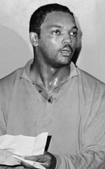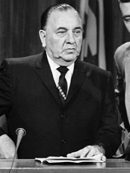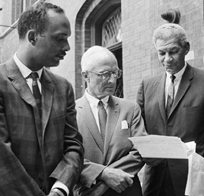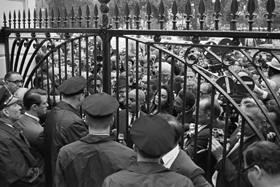At Canaan's Edge (185 page)
Authors: Taylor Branch

With his son Marty and daughter Yolanda
(squeezed next to Hosea Williams)
, King hur-ries through a rural Alabama rainstorm in spring 1966 to encourage registration under the Voting Rights Act.
25

A large crowd in back-alley Chicago hears King's pitch to build a movement against slum conditions in their heartland city.
26

In January of 1966, King begins the Chicago campaign by moving into a freezing, dilapi-dated tenement on the West Side.
27

Seminary student Jesse Jackson leads marches against segregated Chicago housing and schools in the summer of 1966.
28

Chicago Mayor Richard Daley mounts programs to reduce urban poverty and discrimination, then switches to repres-sion when shocking violence against King's integration movement threatens the Democratic power base in white neighborhoods.
29

Summit negotiators Al Raby
(left)
, Ross Beatty of the Chicago Real Estate Board
(center)
, and Edwin “Bill” Berry of the Chicago Urban League inspect an open-housing agreement in late August 1966. King's Chicago campaign national-ized the issues of poverty and racial injustice but failed to draw a broad response like Selma.
30

A march of 200 miles through Mississippi becomes a political and cultural watershed in June of 1966, after integration pioneer James Meredith was shot trying to prove that it was safe for black people to walk in his home state.
31

The new SNCC chairman Stokely Carmichael proclaims a “black power” slogan at the Meredith March rally in Greenwood on June 16, six weeks after his independ-ent voting effort in Lowndes County was either scorned or ignored.
32

At a night meeting
(clock-wise from left)
, Bernard Lee, Andrew Young, Robert Green, King, Lawrence Guyot, Harry Bowie, and Stokely Carmichael struggle to maintain unity on the Meredith March.
33

Behind sensational public controversy over black power and Vietnam, the Meredith marchers recruit new voters such as 104-year-old Ed Fondren, hoisted with his first registration card out-side the Panola County, Mississippi, courthouse.
34

In September 1966, King escorts students with Andrew Young, Joan Baez, and Hosea Williams
(behind, left to right)
past adult mobs that have terrorized black children outside the schools of Grenada, Mississippi.
35

A weary King waits with Andrew Young for a flight out of Mississippi.
36

